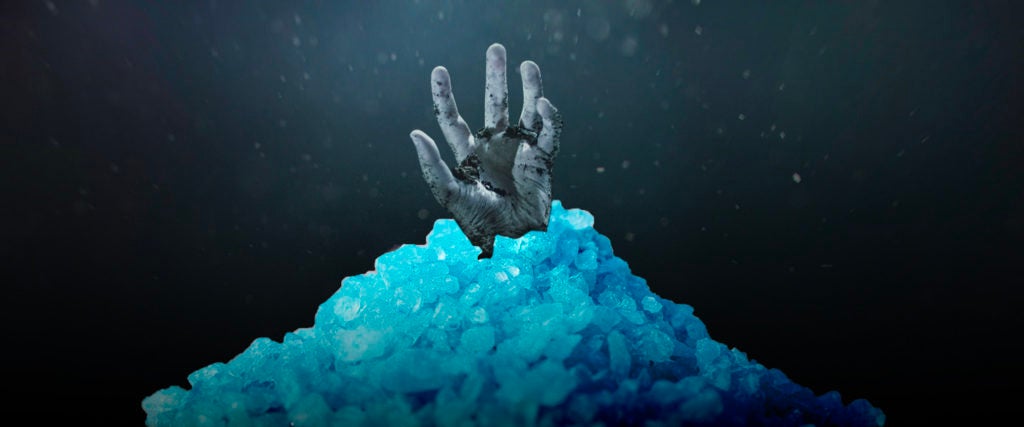A decade ago, America was gripped in a moral panic over a strange new drug that was hard to define but seemingly pushed people to the brink of sanity. It was a legal high that skirted existing laws, sold in convenience stores, head shops and websites as a party-friend upper with little explanation of provenance or purity. Soon, the white powder gained both a reputation for triggering volatility in people and an innocuous nickname: Bath salts.
News reports dramatically highlighted instances of users behaving erratically on bath salts, losing all sense of reality and even attacking people around them. One viral account from Miami involved a young man who attempted to eat the face off of a homeless passerby, earning him the nickname “Miami Zombie.” Other high-profile cases featured people doing things like digging “wire” out of their skin and abandoning their baby in the middle of a highway. Police and doctors gave hyperventilating quotes to the press, claiming that people on bath salts had “superhuman strength” and were uncontrollable.
Why that happened remains a mystery to many experts. “Bath salts” describes a litany of synthetic chemicals that are analogues of cathinone, an alkaloid found in the khat plant, grown and used across Africa and Arabia for centuries for its stimulating effects when chewed. Synthetic cathinones reportedly have a similar effect to amphetamines and MDMA, giving a burst of energy layered with euphoria and a loss of inhibition.
The trend began taking off in 2010, and by December, the American Association of Poison Control Centers reported 304 cases of bath-salt intoxication across the country. In 2011, poison centers took more than 6,100 calls from emergency rooms for advice on how to treat bath-salt abuse. Law enforcement began cracking down on bath salts in full at that point, leading to a ban by the federal government in 2012 under a sweeping law that targeted various kinds of synthetic psychoactives.
Since then, the visibility of bath salts in the media has all but disappeared — and with the passage of time and prohibition, it seems usage has waned as well.
Per the DEA, the number of cases of synthetic cathinone use fell by 28 percent between 2018 and 2019, from 13,226 reports to 9,575. And according to Lawrence Weinstein, chief medical officer of American Addiction Centers, “bath salts” aren’t a prevalent issue when it comes to addiction. “A number of studies have found that regular use of bath salts or synthetic cathinones is not very prevalent in the U.S., and the demand may have even lessened,” he writes over email. “Its usage still occurs as they’re still around and available online and easily obtained at some shops. But from our perspective, coming across cathinones in our patient population is very infrequent.”
The DEA’s data suggests that the most popular synthetic cathinone today is eutylone, a drug often used as an adulterant or replacement for MDMA. And that’s perhaps the most frustrating part about bath salts — on paper, they shouldn’t necessarily cause harm. But the lack of identification, testing and controls on purity mean that bath salts continue to exist in a murky gray area that makes them near impossible to use ethically. There are lingering reports of bath salts being fraudulently sold as meth across the U.S. More significantly, disruptions to MDMA supply often lead traffickers to push synthetics into drug markets, leading to uninformed use, overdoses and surprise side effects.
“They come in, and they’re either psychotic, comatose or in cardiac arrest,” Ohio emergency physician Howard Mell told CBS in 2012. “Their body essentially goes into overdrive — their temperature and heart rate go through the roof, their blood can become acidic and their body cooks.”
This wasn’t what Dr. Zee, the anonymous Israeli researcher who pioneered synthetic cathinone production, had in mind when he made a breakthrough in 2003 and began selling legal pills in Israel, which became a hit with people looking for an ecstasy-like buzz. Mephedrone was first synthesized in 1929, but remained in obscurity until it was rediscovered by Zee and became a signature ingredient in many bath-salt formulations in the early 2010s. In the footsteps of Alexander Shulgin, Zee tested every novel synthetic he produced on himself first. Ultimately, he was disappointed to see mephedrone spread across Europe and into China, where Zee claims labs “reverse-engineered” the chemical and began producing it at scale.
“It only had recreational value,” he told TalkingDrugs.org in 2019. “And it was too moreish… you can’t just take some and then stop. If someone can do that, that person deserves a medal.”
Maybe it’s a good thing after all, then, that a moral panic and ensuing crackdown on bath salts has led to a decline in its use. But it’s also a reflection of an American war on drugs that has quashed lives and scientific innovation alike. No number of new laws and definitions, including the ban on bath salts and similar synthetics, has been able to keep up with the cutting edge of drug alchemy.
Meanwhile, poorly synthesized legal highs continue to get people sick, and they persist in the market largely because of the prohibition on popular recreational drugs like MDMA and cannabis. That prohibition creates a profit motive to find loopholes in the law and distribute as much of a “legal” drug as possible before regulators crack down on it, with all kinds of variances in purity and formulation.
More drug-based moral panics will surely arise again in the future, but they’re not always what they seem. As it turns out, the “Miami Zombie,” Rudy Eugene, didn’t have a trace of any bath salt chemicals in his system — just marijuana. Bath salts present a lot of potential issues, but the biggest may be our inability to understand why these drugs continue to exist — and how to deal with them beyond implementing ban after ban after ban.

